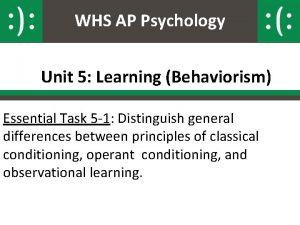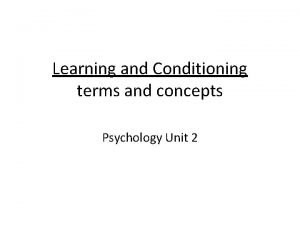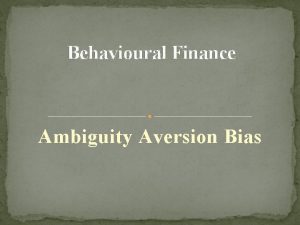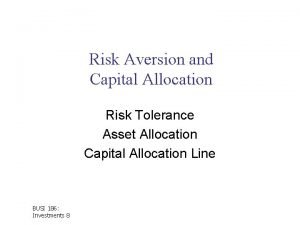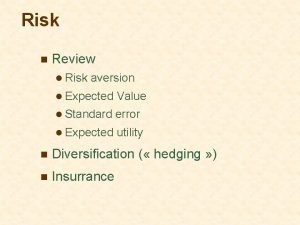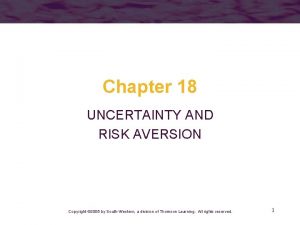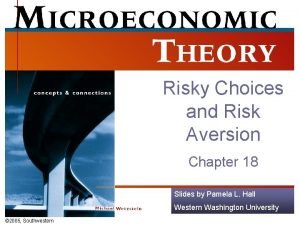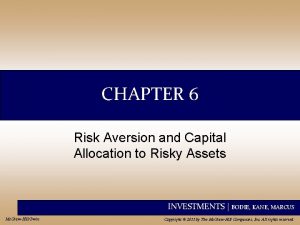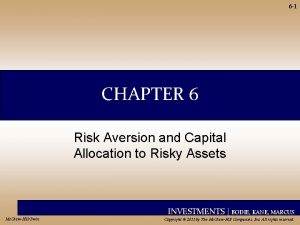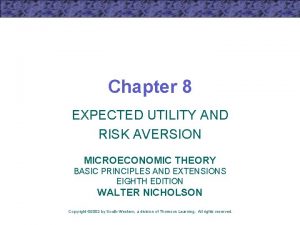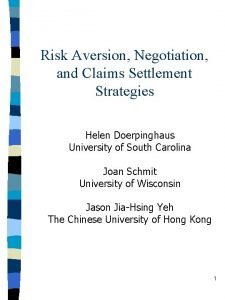Risk and Risk Aversion Chapter 6 Mc GrawHillIrwin













- Slides: 13

Risk and Risk Aversion Chapter 6 Mc. Graw-Hill/Irwin Copyright © 2005 by The Mc. Graw-Hill Companies, Inc. All rights reserved.

Risk - Uncertain Outcomes p =. 6 W 1 = 150 Profit = 50 W = 100 1 -p =. 4 W 2 = 80 Profit = -20 E(W) = p. W 1 + (1 -p)W 2 = 6 (150) +. 4(80) = 122 2 = p[W 1 - E(W)]2 + (1 -p) [W 2 - E(W)]2 =. 6 (150 -122)2 +. 4(80=122)2 = 1, 176, 000 = 34. 293 6 -2

Risky Investments with Risk-Free Risky Inv. 100 p =. 6 1 -p =. 4 Risk Free T-bills W 1 = 150 Profit = 50 W 2 = 80 Profit = -20 Profit = 5 Risk Premium = 17 6 -3

Risk Aversion & Utility Investor’s view of risk Risk Averse Risk Neutral Risk Seeking Utility Function U = E ( r ) -. 005 A 2 A measures the degree of risk aversion 6 -4

Risk Aversion and Value: U = E ( r ) -. 005 A 2 =. 22 -. 005 A (34%) 2 Risk Aversion A Value High 5 -6. 90 3 4. 66 Low 1 16. 22 T-bill = 5% 6 -5

Dominance Principle Expected Return 4 2 3 1 Variance or Standard Deviation • 2 dominates 1; has a higher return • 2 dominates 3; has a lower risk • 4 dominates 3; has a higher return 6 -6

Utility and Indifference Curves Represent an investor’s willingness to trade-off return and risk. Example Exp Ret 10 15 20 25 St Deviation U=E ( r ) -. 005 A 2 20. 0 2 25. 5 2 30. 0 2 33. 9 2 6 -7

Indifference Curves Expected Return Increasing Utility Standard Deviation 6 -8

Expected Return Rule 1 : The return for an asset is the probability weighted average return in all scenarios. 6 -9

Variance of Return Rule 2: The variance of an asset’s return is the expected value of the squared deviations from the expected return. 6 -10

Return on a Portfolio Rule 3: The rate of return on a portfolio is a weighted average of the rates of return of each asset comprising the portfolio, with the portfolio proportions as weights. rp = W 1 r 1 + W 2 r 2 W 1 = Proportion of funds in Security 1 W 2 = Proportion of funds in Security 2 r 1 = Expected return on Security 1 r 2 = Expected return on Security 2 6 -11

Portfolio Risk with Risk-Free Asset Rule 4: When a risky asset is combined with a risk-free asset, the portfolio standard deviation equals the risky asset’s standard deviation multiplied by the portfolio proportion invested in the risky asset. 6 -12

Portfolio Risk Rule 5: When two risky assets with variances 12 and 22, respectively, are combined into a portfolio with portfolio weights w 1 and w 2, respectively, the portfolio variance is given by: p 2 = w 12 12 + w 22 22 + 2 W 1 W 2 Cov(r 1 r 2) = Covariance of returns for Security 1 and Security 2 6 -13
 Risk aversion indifference curve
Risk aversion indifference curve Endowment effect and loss aversion
Endowment effect and loss aversion Behaviorism ap psych
Behaviorism ap psych Inequality aversion
Inequality aversion Ivan pavlov classical conditioning
Ivan pavlov classical conditioning Pavlovian response
Pavlovian response Behavioural finance
Behavioural finance Evaluation of aversion therapy
Evaluation of aversion therapy Aversion therapy evaluation
Aversion therapy evaluation Market risk assessment
Market risk assessment Residual risk and secondary risk pmp
Residual risk and secondary risk pmp Business risk and financial risk leverage
Business risk and financial risk leverage Attributable risk
Attributable risk Measure of association formula
Measure of association formula


